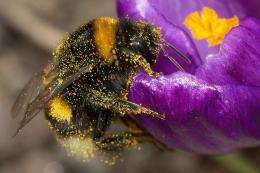Bumblebee genomes give insights into threats to pollinators

The first full genome sequences of two bumblebee species are published this week in the open access journal Genome Biology. They give insights into the genetic basis and evolution of important aspects of bumblebee biology from social living to coping with chemicals and diseases. These insights provide valuable hints about threats to bees' wellbeing and could help prevent further population declines of these key pollinators.
A more in-depth companion paper on the evolution of immune genes within bees shows the number of immune genes remains consistent regardless of bees' degree of sociality, an aspect earlier suggested to influence immune gene numbers. This suggests the basic organization of bee immunity predates the evolution of sociality.
The European buff-tailed (Bombus terrestris) and the North American common eastern bumblebee (Bombus impatiens) were sequenced and analyzed by an international team of scientists; but this is really only the beginning of a new era for bumblebee research, as these genomes will facilitate many future high-throughput functional studies to advance our knowledge of these engaging and essential insects and ensure their conservation. "The sequencing and annotation of these bumblebee genomes constitute a great leap forward for the study of bee biology and understanding the organization of insect societies," says Ben Sadd, Illinois State University.
Using individual bees from Thurgau, Switzerland, and Michigan, USA, the researchers focused on identifying similarities and differences between the transatlantic cousins to understand their basic biology and to shed light on possible clues about their susceptibility to threats like pesticides and diseases. "We remain far from understanding the threats to bumblebees, but molecular insights about their genes are vital to help us understand how bumblebees and diseases interact and what is putting populations of bumblebees at risk," says Ben Sadd.
Bumblebees, such as those sequenced, have different colony lifestyles than honeybees. Bumblebees live in colonies of hundreds rather than thousands of individuals and have less advanced social behaviours than honeybees. On the spectrum of social organization, most bumblebees have what is described as an intermediate structure, lying between completely solitary bees and the extreme social adaptations seen in highly social honeybees.
The limited immune gene repertoire of honeybees was believed to be a consequence of sociality. Honeybees tend to live in densely populated colonies with thousands of closely related individual bees, which are ideal conditions for the spread of infectious diseases. Despite the greater risk of disease, the highly social honeybee was thought to have fewer immune genes than non-bee solitary insects because of the extensive social defences available in colonies like grooming or other sanitary behaviours. Surprisingly though, a reduced number of immune genes is found also in the bumblebees and is consistent with the highly social honeybee and a solitary bee.
Seth Barribeau, East Carolina University, USA, says "Despite bumblebees having simpler colony organization and shorter colony lifespan, they have a remarkably similar repertoire of immune genes to the highly social honeybee (Apis mellifera), and even more surprising, are similar to the solitary leaf-cutting bee (Megachile rotundata)."
The similarity between social and solitary bees suggests that the immune system of bees has remained largely the same since before the origin of bee sociality. The authors speculate that this reduced immunity may even have provided a route to advanced social living. However, "despite the similarity across bees in terms of the broad complement of genes present we do find distinct signatures of selection in the different lineages suggesting that these bees have faced selection from different parasites in their past", says Seth Barribeau.
The in depth analyses of immune system architecture and evolution of these key pollinators is crucial given the threats they face from diseases. This along with the broader analyses of the bumblebee genomes as a whole will not only increase understanding of bumblebee biology, but also facilitate the conservation of these key pollinating insects.
More information: The genomes of two key bumblebee species with primitive eusocial organization, Ben Sadd, Seth Barribeau, Guy Bloch, Dirk C.Graaf, et al. Genome Biology 2015, dx.doi.org/10.1186/s13059-015-0623-y
A depauperate immune repertoire precedes evolution of sociality in bees, Seth Barribeau, Ben Sadd, Louis du Plessis, et al. Genome Biology 2015. dx.doi.org/10.1186/s13059-015-0628-y
Journal information: Genome Biology
Provided by BioMed Central


















